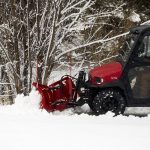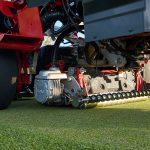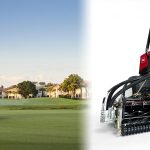What You Need To Know About Electric Reels
The golf industry is always searching for better solutions to manage its unique equipment requirements on golf courses. As global warming becomes a hot issue, the golf industry, like others, is feeling the pressure to deliver environmentally friendly solutions to slow down the effects of climate change. The use of electric drive systems on greensmowers is becoming the latest marketing hype for those in the golf equipment industry. Unfortunately, some manufacturers claims are misunderstood, misleading, or even false about the benefits of electric-driven reels in regard to quality of cut and/or lowering noise. Listed below are some myths about electric reels and things to keep in mind in order to make a more informed buying decision.
Myth #1:
Electric reels offer a better quality of cut
The Real Story:
A hydraulic motor performing according to specifications and turning at the correct speed cuts just as well as an electric motor performing to specifications. One claim states that due to a heavy load the engine slows down, resulting in a reduced traction speed. Electric reels allow the reel speed to be kept high for better cutting. This is false because by keeping the reel speed high the clip will get shorter during that stretch. In essence, the cutting consistency will change and the quality of cut is compromised. On traditionally powered reels, the reel and traction speed remain proportional and maintain a consistent cutting quality.
Myth #2:
Electric reel speed is independent of traction speed
The Real Story:
Greensmowers with independent reel and traction speeds allow you to keep the reel speed up while reducing the traction speed for a smaller clip. This will result in a finer cut and eliminate the need for double cutting. This claim is false because the benefit of double cutting is achieved by cutting in two different directions. Furthermore, there are additional important negatives with independent reel and traction speed control.
- Leaving the control of the reel speed to the operator gives him full control of the clip rate. In theory that sounds good, but it is not practical. This increases the risk of clip rate variation and inconsistent greens.
- Operators typically reduce the traction speed by throttling back the engine on the clean up cut to retain an accurate edge. With independent traction control, only the traction speed will be reduced while the reel continues at a high speed. In time, this will thin out the turf on the clean up cut.
- Many factors determine quality of cut, and the speed of the reel is only one of them. There is an optimal window in the relationship between the reel and traction speed to achieve the most effective cutting. Running the reel too fast may result in bruising the grass blades by striking them multiple times.
Myth #3:
Electric reel drives reduce hydraulic oil leak potential
The Real Story:
This statement is true. However, riders still have hydraulic oil on board to power the cutting unit lift and traction circuit, which pose potential oil leaks. Furthermore, the dual power source of an electric generator and hydraulic pump adds substantial weight, which is detrimental to turf marking from cutting units and tires especially on soft turf. Hydraulic component and equipment manufacturers have worked tediously to make improvements to overcome the leak issueand with great success. Today hydraulic leak issues are rare. It is safe to say that hydraulic components have superior performance attributes in terms of power transmission and reliability. They are also lightweight, which helps minimize turf compaction.
Myth #4:
Engine-driven generator powering electric reels lowers noise
Riders:
The Real Story:
With an electrical reel, noise reduction is accomplished through engine RPM reduction. However, at reduced 2250 RPM, the operation is compromised. The mower can only handle light loads and reducing traction speed drastically reduces productivity. Noise emission of that particular model is high in comparison to other products. Furthermore, clip rate will change when traction speed is reduced and reel speed is kept up, resulting in inconsistent quality of cut. If the reel spins too fast, the grass blades will be struck multiple times, eventually bruising the grass.
Walkers:
The Real Story:
There are batteries and engine-powered electric reel drive systems. The battery-powered systems eliminate noise to a level where only the mechanical noise of the reel and bedknife can be heard. The drawback on these models is the range limitation, which then requires a battery change-out system. There is also an engine-powered generator model, which does not result in any noise or oil leak prevention advantage. Both walker models are being touted for their independent reel and traction speed. Please refer to myth #1 and #2 to fully understand the pros and cons.
In Summary
The electric mowing technology is undergoing an evolutionary period. Its newness results in much hype. We attempted to bring some clarity to this subject. Obviously, there is much work to be done to perfect these systems for mowing applications. In the meantime, it is important that you evaluate the pros and cons to make the best purchasing decisions.





